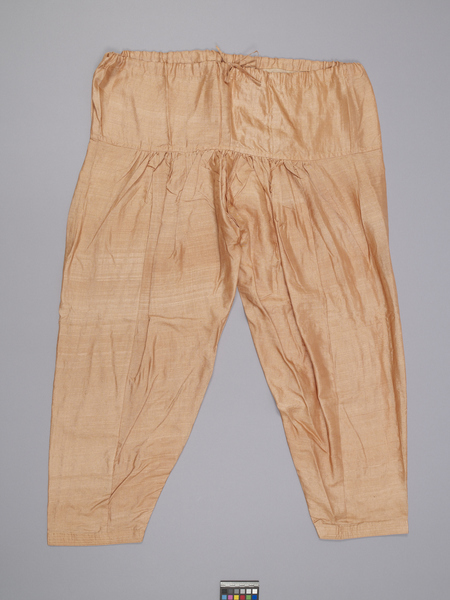Pants Item Number: 3132/2 b from the MOA: University of British Columbia

Description
Baggy shalvaar style pants, worn with a long tunic (part a), and veil or shawl (part c), as part of a wedding ensemble. Pants are made of wild tussar silk in a light orange-brown colour and have a wide waist band, with pull-string that ties at the front. Legs are pleated at top front, loose through the thigh and tapering toward the ankle, where hem is stitched five times. The garment is otherwise undecorated. Interior is lined with silk fabric in a course weave.
Cultural Context
weddings; ceremonial
Narrative
This three-piece raw silk wedding ensemble was commissioned in the 1980s by friends of the bride, Ms. C. Aiyar. Ms. Aiyar, Hindu, came from Tamil Nadu in South India, however the style of this garment is more of a northern style (e.g., salwar/chemise rather than sari), likely because she was marrying a groom from North India. The colour is also unusual, as most Hindu brides prefer to marry in bright red saris. The natural (un-dyed) colour of this material is said to be associated with renunciation and contemplation. It was chosen because the bride had lived with her parents in an ashram until she was 16 years old, when she married.
Specific Techniques
The raw silk fabric was hand-woven. India is the second largest producer of tussar silk, which is produced by tribal groups living in the sub-tropical forested regions.
Item History
- Made in Tamil Nadu, India during 1985
- Owned by Gillian Darling Kovanic and C. Aiyar
- Owned by Rudi Kovanic before September 29, 2015
- Received from Rudi Kovanic (Donor) on September 29, 2015
What
- Name
- Pants
- Identification Number
- 3132/2 b
- Type of Item
- pant
- Material
- silk fibre
- Overall
- height 100.6 cm, width 88.5 cm
Who
- Culture
- South India
- Previous Owner
- Gillian Darling Kovanic, C. Aiyar and Rudi Kovanic
- Received from
- Rudi Kovanic (Donor)
Where
- Holding Institution
- MOA: University of British Columbia
- Made in
- Tamil Nadu, India
When
- Creation Date
- during 1985
- Ownership Date
- before September 29, 2015
- Acquisition Date
- on September 29, 2015
Other
- Item Classes
- textiles
- Condition
- good
- Accession Number
- 3132/0002 b